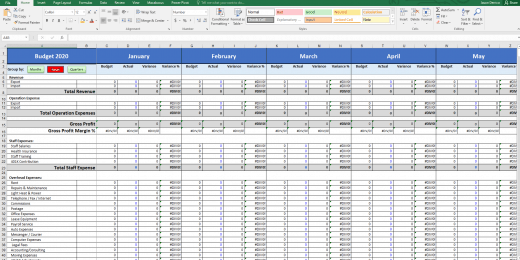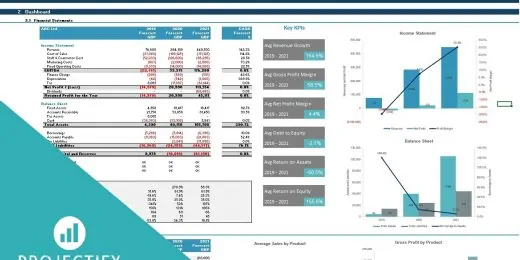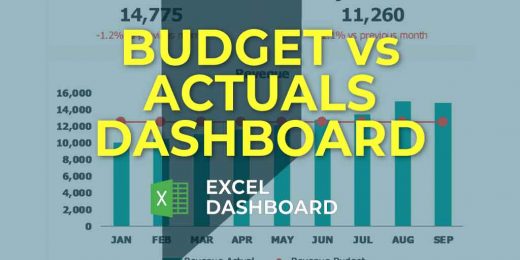Master Your Finances With Key Financial Indicators

Mastering your finances hinges on tracking key financial indicators. These metrics provide insights into financial health and performance.
Navigating the financial landscape requires a solid grasp on several crucial indicators that reflect the state of your finances. Whether you’re a seasoned investor, a small business owner, or just starting to manage your personal finances, understanding these indicators can be the difference between thriving and merely surviving.
Essential metrics like the debt-to-income ratio, savings rate, and credit score are more than mere numbers; they serve as a dashboard for your economic stability. By keeping an eye on these metrics, one can make informed decisions, spot potential issues early, and set realistic goals. These financial indicators also aid in crafting a robust budget, ensuring sufficient savings, maintaining healthy credit, and investing wisely, propelling you toward financial success.
Unlocking The Mysteries Of Financial Health
Understanding your financial health is like unlocking a treasure chest. It’s full of secrets and riches, just waiting for the right key. That key is knowledge about key financial indicators. Let’s dive into what makes your financial health tick and learn how to master your finances!
The Importance Of Financial Indicators
Financial indicators are like a health report card for your money. They show you where you’re doing great and where you need to improve. Strong financial indicators often mean you can grab opportunities or dodge problems. They are crucial for anyone wanting to be in charge of their finances.
Consider these key indicators:
- Debt-to-Income Ratio: It tells you how much debt you have compared to your income.
- Net Worth: This is what you own minus what you owe.
- Savings Rate: This shows how much of your income you’re saving.
Decoding Financial Jargon
Financial terms can seem complex, like a maze. But fear not! Breaking down this jargon into easier words can make a big difference. You don’t need to be an expert. Just knowing a few key terms can help you make better decisions.
| Term | Definition |
|---|---|
| Assets | Things you own that have value |
| Liabilities | Money you owe to others |
| Liquidity | How quickly you can turn assets into cash |
Income Statement Essentials
Understanding the ‘Income Statement Essentials’ is key to mastering your finances. It shows how much money you make and spend. Let’s unpack the crucial parts of the income statement.
Revenue Trends
Tracking revenue trends helps you see if your money grows. Look for patterns like more sales in summer or during holidays. This knowledge can guide your business moves.
- Monthly increases signal growth.
- Seasonal spikes require planning.
- A flat line might mean you should change your strategy.
Profit Margins
Profit margins tell if you’re making enough money from sales. Compare your profits to your costs. High profits mean you’re on the right track.
| Year | Revenue | Expenses | Profit Margin |
|---|---|---|---|
| 2021 | $200,000 | $150,000 | 25% |
| 2022 | $220,000 | $165,000 | 25% |
Expense Analysis
Expense analysis stops money leaks. It shows where your money goes. Keep your costs lower than your income to make money.
- Group expenses by type.
- Find big costs you can cut.
- Plan how to spend less.
The Power Of The Balance Sheet
Understanding a balance sheet is like having a financial map in your hands. It paints a clear picture of what a company owns and owes, at a specific point in time. This snapshot is vital for making informed decisions.
Assets Overview
Assets are what a company owns. They can help a business make more money.
Types of assets include:
- Cash: Money the company can use right away.
- Investments: Stocks or bonds that can be sold for cash.
- Property: Physical items like buildings and machines.
- Inventory: Goods ready to sell.
Assets are a key part to any balance sheet and show true value.
Liabilities In Focus
Liabilities are what a company must pay back.
Common liabilities include:
- Loans: Borrowed money to be paid back.
- Accounts Payable: Bills due soon.
Looking at liabilities tells us about a company’s debts.
Shareholders’ Equity Explained
Shareholders’ equity is the value left after paying all debts.
It’s found by subtracting liabilities from assets.
It includes:
- Stock: Money from shares sold.
- Retained Earnings: Profits not given to shareholders yet.
High equity means the company is funded by owners more than loans.
Cash Flow Statement Insights
Understanding your cash flow statement is like having a financial map. It guides you through business decisions, showing the paths of incoming and outgoing money. This statement offers a clear view of financial health. Let’s dive deep into its key components for mastering your finances.
Operating Cash Flow
Operating cash flow tells you cash generated from daily business. It’s the money from selling products or services. A positive number means you’re earning more than you spend. It’s crucial to cover expenses and grow. Look for trends in this metric to predict future performance.
Investing And Financing Cash Flow
Investing activities reflect money spent or earned from investments, like buying or selling assets. Financing activities show cash exchanges with lenders and shareholders.
- Investing cash flow indicates resource allocation for growing the company.
- Financing cash flow reveals how a business funds its operations, through debt or by issuing stock.
Free Cash Flow Significance
Free cash flow is leftover money after maintaining or expanding assets. It’s key for flexibility. Companies use it to pay debt, distribute dividends, or invest further. A robust free cash flow suggests a company can sustain and enhance shareholder value.
| Cash Flow Type | Significance |
|---|---|
| Operating | Tracks daily business earnings |
| Investing | Shows long-term investment gains or losses |
| Financing | Reflects funding strategies via debt or equity |
| Free Cash Flow | Indicates financial flexibility and growth potential |
Key Ratios For Financial Mastery
Mastering your finances begins with understanding key financial ratios. These tools give a snapshot of your fiscal health. They help in making informed decisions. Let’s dive into important ratios for financial mastery.
Liquidity Ratios
Liquidity ratios measure how easily assets can turn into cash. This is crucial to cover short-term obligations. High liquidity means more cash at hand for emergencies or investments.
- Current Ratio: Total current assets divided by total current liabilities.
- Quick Ratio: (Total current assets – inventory) divided by total current liabilities.
Solvency Ratios
Solvency ratios indicate long-term stability and the capacity to meet long-term obligations. They show if a company can survive over long periods.
| Ratio | Formula |
|---|---|
| Debt-to-Equity Ratio | Total Liabilities / Shareholders’ Equity |
| Interest Coverage Ratio | Earnings Before Interest and Taxes (EBIT) / Interest Expense |
Profitability Ratios
Profitability ratios reveal how well a company uses its assets to generate profits. High values usually indicate good company health.
- Net Profit Margin: Net income divided by revenue.
- Return on Assets (ROA): Net income divided by total assets.
- Return on Equity (ROE): Net income divided by shareholders’ equity.
Debt And Leverage
Moving onto a crucial aspect of mastering your finances, we delve into Debt and Leverage. These indicators are pivotal for a clear financial picture. Debt shows what you owe; leverage how much you rely on borrowed funds. Grasping them empowers you to control financial health.
Debt Ratio Analysis
Debt ratio analysis enlightens you on how much debt your company carries relative to its assets. A lower ratio signals stronger financial stability. It means your company isn’t overburdened by debt.
A simple formula to calculate debt ratio: Total Debt / Total Assets.
- High debt ratio greater than 1: Assets are less than liabilities.
- Moderate debt ratio around 0.5: Balanced approach to financing.
- Low debt ratio less than 0.5: Company depends more on equity than debt.
A well-balanced debt ratio sustains company growth and manages risk effectively.
Understanding Leverage
Leverage is using borrowed capital for investment, expecting the profits made to be greater than the interest payable. With leverage, companies can amplify investment power.
Simple leverage benchmarks:
| Degree of Leverage | Implication |
|---|---|
| High Leverage | Risky, with potential for higher returns |
| Moderate Leverage | Balanced risk and reward |
| Low Leverage | Safe, less exposure to debt |
Financial leverage can boost growth, but it adds risk. Adequate control over leverage ratios is essential. This duality makes understanding leverage a potent skill in mastering finances.
Investment Indicators For The Savvy Investor
Understanding key investment indicators can make the difference between growing wealth or missing opportunities. These metrics provide insight into a company’s health and potential for growth. They help investors make informed decisions. Get ready to learn about vital investment indicators such as ROI, ROE, earnings per share, and the price-to-earnings ratio.
Roi And Roe
Return on Investment (ROI) measures the gain from an investment relative to its cost. It’s a tool investors use to compare the efficiency of different investments. A high ROI means the investment gains compare favorably to their cost. Return on Equity (ROE), by contrast, measures the profitability of a company by revealing how much profit a company generates with the money from shareholders.
| Indicator | Purpose | Interpretation |
|---|---|---|
| ROI | To evaluate the efficiency of an investment. | Higher ROI signals better investment efficiency. |
| ROE | To assess a company’s profitability. | Higher ROE indicates more profit per shareholder dollar. |
Earnings Per Share
Earnings per Share (EPS) is a direct reflection of a company’s profitability. It is calculated by dividing the company’s profit by the total number of outstanding shares. A higher EPS suggests a company is more profitable and has higher earnings available for shareholders.
- Earnings per Share = Net Income / Outstanding Shares
- High EPS can mean better financial health.
Price-to-earnings Ratio
The Price-to-Earnings (P/E) Ratio compares a company’s stock price to its earnings per share. This indicator helps investors decide if a stock’s price is overvalued or undervalued. A lower P/E ratio could mean the stock is currently undervalued. Contrastingly, a high P/E could indicate an overvalued stock or investors’ expectations of higher future earnings.
- Price-to-Earnings Ratio = Stock Price / Earnings per Share
- Lower P/E may suggest an undervalued stock.
- Higher P/E could hint at overvaluation or high growth expectations.
Tracking Performance With Kpis
Mastering your finances requires a clear understanding of your financial health.
It is like having a financial dashboard for your life.
What Are Kpis?
Key Performance Indicators, or KPIs, assess financial success.
They act as benchmarks to track progress toward goals.
Common financial KPIs include cash flow, profit margins, and debt ratios.
Custom Kpis For Your Goals
Custom KPIs align with individual goals and strategies.
They personalize the approach to tracking financial success.
| Goal Type | KPI Example |
|---|---|
| Savings Growth | Monthly Savings Rate |
| Investment Performance | Return on Investment (ROI) |
| Expense Management | Expense-to-Income Ratio |
Create KPIs that reflect short-term achievements and long-term objectives.
Financial Planning And Analysis
Understanding your finances is like knowing the score in a game. Good financial planning and analysis can help you win financially. It guides you to make smart moves with your money. You can learn what works well and fix what doesn’t.
Budgeting Basics
A budget is like a map for your money. It tells you where each dollar should go. Start simple:
- Track your income: Write down how much money you get.
- List your expenses: Record your spending. This includes bills and shopping.
- Set goals: Decide what you want to save for. It can be big or small.
- Adjust as needed: Sometimes, you spend more or less. Change your budget if this happens.
Forecasting Future Performance
Forecasting is like a weather report for your finances. It helps you plan for the sunny and rainy days. Use past data to guess future trends:
- Look at past earnings.
- Think about market changes.
- Remember your financial goals.
This way, you can make smarter decisions for your future money.
Variance Analysis
Variance analysis is financial detective work. It compares what you planned to spend with what you actually spent. It can show areas to focus on:
| Planned | Actual | Difference | Action |
|---|---|---|---|
| $1000 | $1200 | $200 over | Find out why and fix it. |
| $2000 | $1800 | $200 under | Maybe reallocate or save. |
Technology In Financial Analysis
Technology in Financial Analysis is transforming how we understand and master our finances. Modern tools make complex tasks simpler and faster. Tracking key financial indicators is not just for experts anymore. With the right technology, anyone can become a financial whiz.
Financial Software Platforms
Financial software platforms are the backbone of personal and business finance management. They provide a centralized space to track expenses, investments, and trends. Users gain insights without drowning in data. Here’s why they stand out:
- User-friendly interfaces guide you with ease.
- Automated reports save time and reduce errors.
- They support budgeting and forecasting, essential for financial health.
The Rise Of Financial Data Analytics
Financial data analytics is a game-changer. It turns numbers into actionable insight. Smart analytics can predict market trends and customer behavior. Benefits include:
- Better investment decisions
- Real-time data for instantaneous strategy shifts
- Risk assessment made simpler and more accurate
Ai And Machine Learning In Finance
AI and machine learning are the frontiers in financial analysis. They spotlight patterns impossible for humans to see. Let’s dive into the advantages:
Automated trading systems can make transactions in milliseconds. Machine learning algorithms enhance credit scoring, making lending faster and fairer. Fraud detection systems powered by AI protect assets more effectively.
| Feature | Benefits |
|---|---|
| Automated Trading | Speed and efficiency in investments |
| Credit Scoring Algorithms | Accurate and unbiased credit assessments |
| Fraud Detection | Enhanced security for financial assets |
Staying Informed And Educated
Want to master your finances? Learn to track important numbers. It’s like a secret code. By understanding financial indicators, you unlock wisdom. Financial wisdom helps you thrive. But it’s not just about knowing numbers. It’s about staying sharp. Let’s explore how.
Keeping Up With Financial News
Financial news moves fast. Stay ahead. Make it a daily ritual. Like brushing your teeth, but for your wallet. Regular news updates keep you clued in. Know what moves markets. Spot trends. Make smarter money decisions.
- Subscribe to finance newsletters. They give you the news you need.
- Use apps to follow stocks or markets. It’s like a financial pulse check.
- Watch reputable TV shows or YouTube channels. They simplify complex topics.
- Read articles and blogs. Dive deep into subjects.
Continuous Learning And Certifications
Finance is a lifelong journey. Each step teaches you more. Want to lead the pack? Keep learning. New tools and strategies pop up often. Stay current. Grow your skills with certifications or courses.
- Pick online courses. They fit into your life easily.
- Earn certificates. They tell everyone you’re serious about money.
- Join workshops or seminars. They are like financial boot camps.
- Seek mentorship. Learn from someone who’s been there.
Case Studies: Financial Turnarounds
A deep dive into financial turnarounds can teach us invaluable lessons. From eye-opening corporate revivals to sobering money woes, case studies show us the power of smart financial decision-making. Let’s explore how some companies managed to pull off miraculous comebacks and what can be learned from those who couldn’t pivot in time.
Successful Corporate Comebacks
Resilience and strategic foresight are hallmarks of successful financial turnarounds. Companies like Apple and Ford faced dire straits but emerged stronger. These stories inspire and educate on the art of financial recovery.
- Apple’s return to profitability in the 2000s showcases innovation and strong leadership.
- Ford’s rebound after the 2008 crisis highlights a meticulous focus on core strengths.
| Company | Challenge | Action Taken | Outcome |
|---|---|---|---|
| Apple | Financial slump | Product innovation | Market leader |
| Ford | Sales decline | Restructuring | Profitable growth |
Lessons From Financial Failures
Not all stories end in triumph. Financial missteps can cripple even the largest corporations. Companies like Enron and Lehman Brothers are cautionary tales, reminding us of the importance of transparency and risk management.
- Enron’s collapse teaches the pitfalls of ethical shortcuts and financial obscurity.
- Lehman Brothers’ downfall shows the dangers of excessive risk and lack of oversight.
By studying these failures, businesses can learn to recognize early warning signs and prioritize long-term sustainability over short-term gains.
Frequently Asked Questions
What Are Key Financial Indicators?
Key financial indicators, also known as financial ratios, are metrics used to assess a company’s financial health. They help in analyzing profitability, liquidity, debt levels, and operational efficiency. Common examples include the debt-to-equity ratio, return on equity, and current ratio.
How Do Financial Ratios Improve Decision Making?
Financial ratios provide critical data for decision making by simplifying complex financial statements. They enable investors and managers to compare performance over time, gauge financial health, and make informed investment or strategic business decisions effectively.
Can Financial Indicators Predict Business Success?
While financial indicators cannot guarantee business success, they are instrumental in forecasting future performance. By analyzing trends and comparing ratios, businesses and investors can identify strengths and potential risks, aiding in strategic planning and investment choices.
Why Is The Current Ratio Important?
The current ratio is important as it measures a company’s ability to pay short-term obligations with its current assets. A higher current ratio indicates better liquidity, suggesting the company is more capable of covering its debts, which is reassuring for creditors and investors.
Conclusion
Understanding key financial indicators is crucial to managing your finances effectively. Master these metrics, and you’ll unlock insights for smarter money decisions. Equip yourself with this knowledge to navigate the financial landscape confidently. Start optimizing your fiscal health today—your future self will thank you.
Embrace the power of financial literacy.



















































